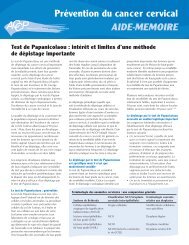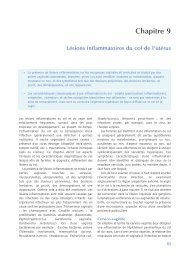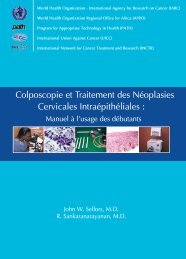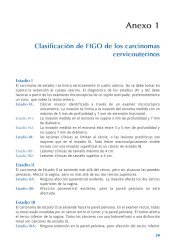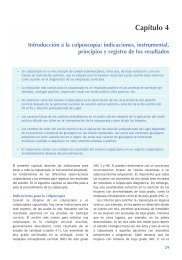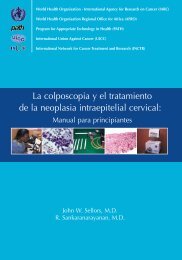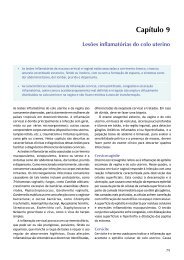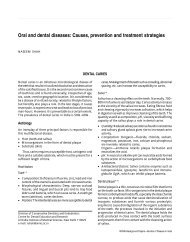Manual for Cytology - IARC Screening Group
Manual for Cytology - IARC Screening Group
Manual for Cytology - IARC Screening Group
Create successful ePaper yourself
Turn your PDF publications into a flip-book with our unique Google optimized e-Paper software.
1<br />
Role of Diagnostic <strong>Cytology</strong><br />
Diagnostic cytology is the science of interpretation of cells that are either exfoliated from<br />
epithelial surfaces or removed from various tissues. George N Papanicolou introduced<br />
cytology as a tool to detect cancer and pre-cancer in 1928. It is now a widely accepted<br />
method <strong>for</strong> mass screening in asymptomatic population. Many European countries have<br />
achieved reduction in incidence of cervical cancer by systematic pap smear screening of<br />
the population.<br />
The advantages of diagnostic cytology are that it is a non-invasive, simple procedure, helps<br />
in faster reporting, is relatively inexpensive, has high population acceptance and facilitates<br />
cancer screening in the field. Diagnostic cytology can be carried out by different methods,<br />
which includes collection and examination of exfoliated cells such as vaginal scrapes, sputum,<br />
urine, body fluids etc. Collection of cells by brushing, scraping or abrasive techniques is<br />
usually employed to confirm or exclude malignancy. Fibreoptic endoscopes and other<br />
procedures can be used <strong>for</strong> collecting samples directly from the internal organs.<br />
Fine-Needle Aspiration <strong>Cytology</strong>/ Biopsy (FNAC/FNAB) is now a widely accepted diagnostic<br />
procedure, which has largely replaced open biopsy. This method is applicable to lesions<br />
that are easily palpable, <strong>for</strong> example swellings in Thyroid, Breast, superficial Lymph node<br />
etc. Imaging techniques, mainly ultra-sonography and computed tomography, offer an<br />
opportunity <strong>for</strong> guided FNAC of deeper structures.<br />
The practice of diagnostic cytology needs proper training of the laboratory personnel including<br />
cytopathologist, cytotechnologist and cytotechnician. The role of cytotechnician is very<br />
important in cancer control programmes where large numbers of asymptomatic population<br />
have to be screened.<br />
The accuracy of the cytologic examination from any body site depends greatly on the quality<br />
of collection, preparation, staining and interpretation of the material. Inadequacy in any of<br />
these steps will adversely affect the quality of diagnostic cytology.<br />
Diagnostic accuracy and reliability are major issues in cytology practice. Over the years<br />
many quality control measures have been introduced <strong>for</strong> ensuring high standards in cytology,<br />
Among them the most important are regular continuing education of medical and technical<br />
personnel, certification and accreditation of laboratory to national authorities such as Indian<br />
Academy of Cytologists (IAC), introduction of quality assurance and quality control measures,<br />
computerization, introduction of internationally accepted terminology, improvement of sample<br />
preparation techniques, quantitative and analytical cytology techniques and advanced<br />
technologies including automation.<br />
9



